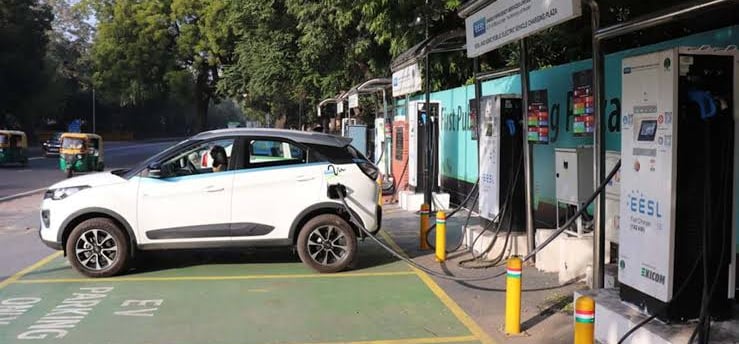Add your promotional text...
Indian EV Market Set for Over 40% CAGR Growth by 2027: Key Insights from Latest Report
Synopsis: India’s electric vehicle (EV) market is on the brink of a major transformation, with growth expected at a 35-40% CAGR by 2027. A report from Niveshaay highlights key factors driving this surge, including government incentives, local manufacturing support, and increasing consumer demand. By 2030, annual EV sales in India could surpass 10 million units, with substantial progress in public charging infrastructure and battery cost reductions, making India a significant player in the global EV landscape.
TOP STORIES
By Vishwash Saxena
9/11/20243 min read


The electric vehicle (EV) industry in India is set for an impressive transformation, with predictions of 35-40% CAGR growth until 2027. A report released by Niveshaay, a company managing the Green Energy smallcase (a specialized portfolio of stocks linked to the renewable energy sector), offers an in-depth look at the projected growth, the challenges ahead, and the strategies being deployed to accelerate EV adoption in India. The report suggests that EV sales in India could soar to between 3 and 4 million units by 2025, and skyrocket to 10 million by 2030.
The Current EV Landscape in India
At present, the Indian EV market is heavily focused on the two- and three-wheeler segments, which together account for 80% of the overall EV market. The significant push towards electric mobility in these segments is partly due to their affordability and the vast urban demand for short-range, economical vehicles.
Government Initiatives Boosting Local Manufacturing
India’s government has taken proactive steps to support the local EV manufacturing industry. Arvind Kothari, founder of Niveshaay, notes that the government’s Production Linked Incentive (PLI) schemes and customs duty reductions on critical minerals are set to strengthen domestic manufacturing. This move aims to reduce dependency on imports, a significant factor in India’s current supply chain.
Kothari further elaborates that India’s balanced approach towards policy support and market growth has positioned the country as an emerging global contender in the EV space. However, challenges remain, notably the limited availability of charging infrastructure, which could impede faster adoption.
EV Market Penetration and Projected Growth
The report emphasizes that electric vehicles are expected to account for around 10-15% of all new vehicle sales in India by 2030. This growth will be driven by a variety of factors, including government incentives, rising fuel costs, and growing consumer awareness about the environmental benefits of EVs.
By 2030, India’s annual EV sales are projected to surpass 10 million units. A substantial portion of this growth will be in the deployment of electric buses, commercial vehicles, and passenger cars. These vehicles are likely to represent 30-40% of all new vehicle sales, indicating a massive shift in India’s automotive market.
Strengthening EV Infrastructure
One of the key factors enabling the expansion of the EV market is the rapid development of EV charging infrastructure. According to the report, over two million public charging stations are expected to be established across India, providing a robust network to support the increasing number of electric vehicles.
Increased Budget Allocations and Policy Support
India’s government has been ramping up its financial commitment to the EV sector. For example, the allocation for the Faster Adoption and Manufacturing of Electric Vehicles (FAME) scheme has seen significant growth. Initially allocated ₹10,000 crore in FY2019-20, the budget for FY2023-24 includes ₹19,744 crore for the Green Hydrogen Mission and ₹2,908 crore for the continued support of the FAME II initiative.
The FAME Initiative, launched in 2015, aims to encourage the adoption of electric and hybrid vehicles through upfront purchase incentives. The Union Budget 2024-25 further reinforces this commitment, allocating ₹2,671.33 crore under the FAME scheme, primarily to address outstanding liabilities from FAME II.
In addition to FAME, the government has introduced the ₹500 crore Electric Mobility Promotion Scheme (EMPS) to specifically target electric two- and three-wheelers.
Incentives for Battery Production and Cost Reduction
One of the most critical barriers to EV adoption is the high cost of batteries, which can account for a significant portion of the total vehicle cost. To make EVs more affordable, the Indian government has increased the budget for the PLI Scheme for the automotive sector to ₹3,500 crore. This funding is aimed at reducing production costs for batteries by offering customs duty exemptions on essential minerals like lithium and cobalt.
This focus on cost reduction, combined with supportive policies, will likely make electric vehicles more accessible to a broader range of consumers in the coming years.
India’s Role in the Global EV Market
While India is still catching up with the global EV leaders, its vast population and rapidly urbanizing landscape make it an ideal market for affordable electric mobility solutions. As China leads the way with 60% of global EV sales in 2023, India’s growing market will continue to be shaped by its unique demographic and geographic challenges.
On the other hand, the U.S. and Europe, which currently have EV penetration rates of 7% and 14% respectively, are more focused on the development of passenger vehicles and infrastructure for long-range driving.
In conclusion, India is on the brink of a major shift in its automotive industry, thanks to concerted efforts from the government and a growing consumer base for electric vehicles. While the market is still in its early stages, particularly when compared to countries like China, the U.S., and Europe, India’s focus on affordability, local manufacturing, and infrastructure development sets it apart as a unique player in the global EV market.
The government’s Initiatives, particularly the PLI and FAME schemes, alongside increasing investment in charging infrastructure and battery cost reductions, indicate a promising future for EVs in India. By 2030, India is expected to not only meet but exceed global expectations in electric mobility, carving out its niche in the international EV landscape.
